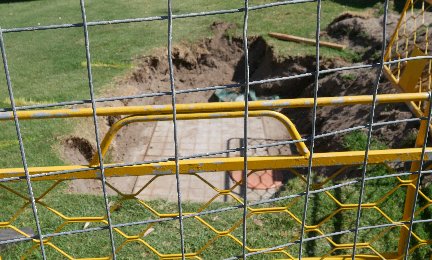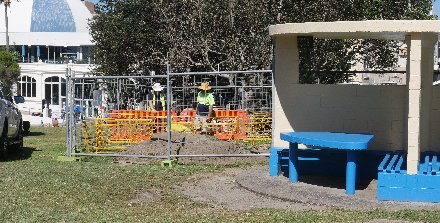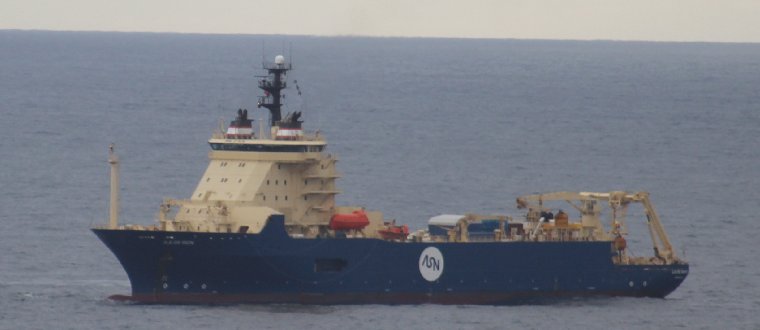
Trench showing manhole cover entrance to cable connection, Dunningham Reserve
HISTORY | STORIES | BEYOND BLOG & CREATE PEOPLE |
Coogee Connection
Independent submarine capacity provider, Southern Cross Cables Limited (Southern Cross), has announced its Southern Cross NEXT cable (SX NEXT) has landed in Coogee Beach
as part of the final stage of the submarine cable rollout between Los Angeles and Sydney.
According to their publicity, once live, the SX NEXT cable (13,483 km long) will provide an additional 72 terabits of data per second between Australia, New Zealand and the United States and provide on-ramp connections to Pacific Islands of Fiji, Tokelau and Kiribati. The 72 terabits of additional capacity is the equivalent of streaming more than 4.5 million Ultra HD 4k videos simultaneously. It will essentially double the amount of direct international cable band width from the east coast of Australia to the West Coast of the United States.

Dunningham Reserve Access Point
The cable's land connection is installed under two large square double man-hole covers in Dunningham Reserve. When we visited the work site in late December 2021, we could see the covers in a trench
about a metre deep, which had been originally installed in 2018 and re-opened for the final phase of the project. Normally they are covered in soil and turf, and would not be noticed by everyday park users. Indeed,
you could picnic over them without realising they were there. We watched as the digger filled in the trench over the covers and workers replaced the turf - it is as if it had never been touched.

Our understanding is that two pipes or ducts designed to house cables run from this site, under the reserve and under Coogee Beach and out into the bay to a total length of 1940 metres (just under two kilometres), where they can then be accessed by machinery and divers from a cable laying ship that has been laying off Coogee for the last week.
The telecommunications services that the cable links with are not located in Coogee; this facility is basically a connection point- the connection must run north to a final destination.

|
|
Cable-laying vessel Ile de Sein has been coming and going from Coogee off the coast of Australia over the last few weeks, completing work associated with the Southern Cross NEXT cable.
She is a Cable Layer that was built in 2001 by the South Korean Hyundai Mipo Dockyard and christened on November 13, 2001 in Ulsan together with the sister ships Ile de Batz and Ile de Brehat
and sails under the French flag. Its home port is Marseilles, in France. It is operated by the telecommunications company Alcatel-Lucent.
Its carrying capacity is 9820 tons DWT and her draught is 7.1 meters. Its length overall (LOA) is 140.36 meters and its width is 23.4 meters. Its gross tonnage is 13,978. The cable layer has exceptional maneuverability and can load up to 7,000 kilometers of submarine cable , which can be laid either up to a depth of 6,000 meters on the sea floor or in a three meter deep self- plowed trench at water depths of up to 1,500 meters An interesting task the ship had to undertake in the past was the vessel was being contracted in 2011 by the French aviation accident investigation bureau to recover the wreckage of the Air France passenger jet that crashed in the mid-Atlantic in 2009 on a trip from Rio de Janeiro and Paris. The wreckage had been found at a depth of 3,900 meters. |
Cable Politics
Continental nations can use existing land based telecommunications networks to expand access to the Internet, and though expensive to do, as engineering projects are not such
difficult undertakings. The Pacific is very different. The vast watery reaches of the Indo-Pacific region with many nations surrounded by oceans,make submarine cabling a vital undertaking.
Super-power competition in the region has left some nations fearful of one country having monopoly power over communications and there is a push at the moment to expand the range of access to cables.
Australia sees the Pacific as its backyard, and has been keen to increase bandwidth and access for the American-Australian networks and between the island nations of the Pacific.
Reference
Copyright © Coogee Media All rights reserved
| CONTACT US | ABOUT US |